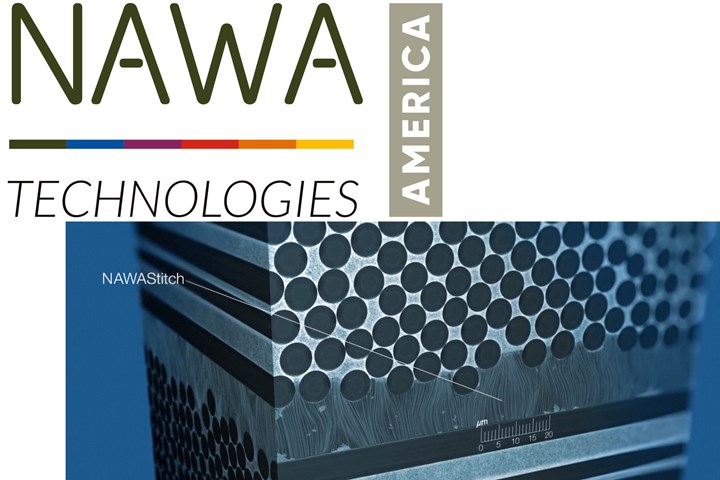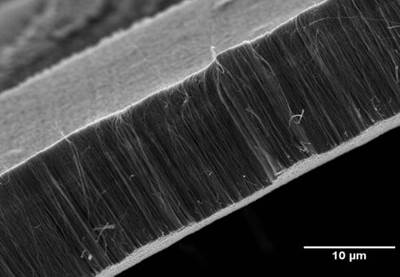NAWA Technologies develops U.S. subsidiary to extend VACNT application scope
NAWA America’s immediate focus is to bring NAWAStitch to mass market, a thin film containing trillions of VACNT arranged perpendicular to the carbon fiber layers to reinforce the weakest part of a composite.
NAWAstich, a thin film containing trillions of VACNT arranged perpendicular o the carbon fiber layers. Photo credit: NAWA Technologies
NAWA Technologies (Aix-en-Provence, France), a company focused on next-generation energy storage systems, reported on Nov. 19 that it has further cemented its position as one of the world’s leading technology innovators, with the announcement of NAWA America, a new U.S.-based company focused on industrializing advanced composite materials.
Based in Dayton, Ohio, NAWA America was created through the acquisition of N12 Technologies (Somerville, Mass., U.S.) a company with a focus in vertically aligned carbon nanotubes (VACNT) for composite applications “see NanoStitch update: 60-inch wide sheet, industrial capacity, dramatic test results”). According to NAWA Technologies, bringing multifunctional ultra-strong composites that are aimed at sectors including automotive, aerospace, renewable energy, space, defense, sporting equipment and consumer and luxury goods is the cornerstone to NAWA America’s development.
“The creation of NAWA America is a very exciting and a natural strategic step. We have been aware of N12 Technologies’ exceptional work for many years; I am delighted the opportunity has arisen to acquire its activities, develop the technology further and bring it within our portfolio,” says Pascal Boulanger, founder of NAWA Technologies, chairman of the Board and CTO.
In the future, NAWA Technologies sees enormous potential in combining NAWAStitch and NAWAShell to create ultra-strong, multifunctional lightweight materials
NAWA America’s main objective will be to significantly widen the range of applications of multifunctional composites, engineering true, next-generation materials and substantially scaling manufacture. Its immediate focus will be on a bringing a new materials concept, NAWAStitch, to mass market. Comprising a thin film containing trillions of VACNT arranged perpendicular to the carbon fiber layers, NAWAStitch acts as ‘nano-velcro,’ reinforcing the weakest part of a composite: the interface between the layers. Eliminating the probability that a crack will occur in the interface, the concept also greatly improves strike damage resistance.
NAWA says that carbon fiber composites with NAWAStitch have their shear strength increased by a factor of 100 and shock resistance by a factor of 10. High-speed impact also results in 50% less interior damage versus a conventional carbon composite. Together, NAWA Technologies contends that this makes NAWAStitch the optimum way to reinforce the mechanical properties of carbon fiber composites.
In addition to continuing all of N12 Technologies’ activities in the VACNT field with existing and new customers, NAWA America has also established a research collaboration and license agreement with the University of Dayton Research Institute (UDRI), through the Multifunctional Structures and Materials Group run by Dr. Paul Kladitis, ranked number one in the U.S. in materials research. The company has also signed a field exclusive license agreement with the Massachusetts Institute of Technology (MIT), through Prof Brian Wardle’s (NECSTLAB) research group, well-known in the fields of composites and nanotubes.
According to the company, synergies already exist with NAWA Technologies. At its headquarters in France, it has independently created a multifunctional composite materials concept, NAWAShell. NAWAShell is an integrated structural hybrid battery, incorporating VACNT to give two complimentary characteristics: enhanced mechanical strength and electrical energy storage within the composite structure’s core. Potential use cases include a solar roof panel in a car that could generate energy stored within the roof, and provide a circular green solution, with almost no additional mass to the vehicle structure.
In the future, NAWA Technologies sees enormous potential in combining NAWAStitch and NAWAShell to create ultra-strong, multifunctional lightweight materials that can also store energy, whether in a vehicle, airplane, building or mobile device
“This move further cements NAWA Technologies as the leading specialist in VACNT, and the largest manufacturer of continuous industrial scaled VACNT,” says Boulanger. “Not only do we possess the rights and know-how for the two most efficient and complementary patented VACNT growth processes, strong academic support from both sides of the Atlantic, but also the expertise to bring two major applications of VACNT to a global market: ultra-strong composites and energy storage. We expect both sectors to grow exponentially over the coming decade. Innovations such as these will have a significant impact on the global search for a fully sustainable world, and also align with NAWA Technologies’ ethos to provide clean, sustainable energy solutions.”
According to Ulrik Grape, CEO of NAWA Technologies NAWA America’s objective is simple. “Combine the expertise that exists within the Dayton operation with that of NAWA Technologies, and harness the potential of our relationships and agreements with UDRI and MIT, in addition to our relationship already existing with CEA. This will allow us to finalize development of NAWAStitch and ramp-up to volume production in 2021. In the short term, our first markets will be sporting equipment, consumer products and luxury goods, while our longer-term focus is automotive and aerospace.”
Related Content
Materials & Processes: Resin matrices for composites
The matrix binds the fiber reinforcement, gives the composite component its shape and determines its surface quality. A composite matrix may be a polymer, ceramic, metal or carbon. Here’s a guide to selection.
Read MorePEEK vs. PEKK vs. PAEK and continuous compression molding
Suppliers of thermoplastics and carbon fiber chime in regarding PEEK vs. PEKK, and now PAEK, as well as in-situ consolidation — the supply chain for thermoplastic tape composites continues to evolve.
Read MoreCarbon fiber in pressure vessels for hydrogen
The emerging H2 economy drives tank development for aircraft, ships and gas transport.
Read MoreCryo-compressed hydrogen, the best solution for storage and refueling stations?
Cryomotive’s CRYOGAS solution claims the highest storage density, lowest refueling cost and widest operating range without H2 losses while using one-fifth the carbon fiber required in compressed gas tanks.
Read MoreRead Next
The end of delamination?
A spin-off from MIT's NECSTlab, N12 Technologies Inc. launches NanoStitch, the world's first vertically aligned CNT product via a continuous industrial process, which bridges adjacent CFRP plies, boosting interlaminar shear and increasing fatigue life by 100%.
Read MoreCW’s 2024 Top Shops survey offers new approach to benchmarking
Respondents that complete the survey by April 30, 2024, have the chance to be recognized as an honoree.
Read MoreFrom the CW Archives: The tale of the thermoplastic cryotank
In 2006, guest columnist Bob Hartunian related the story of his efforts two decades prior, while at McDonnell Douglas, to develop a thermoplastic composite crytank for hydrogen storage. He learned a lot of lessons.
Read More

















.jpg;maxWidth=300;quality=90)









